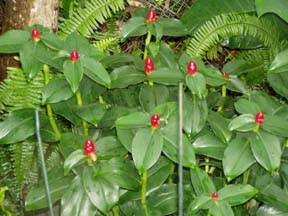

Allow the cut ends to dry out for a day, laying flat. Cut away and discard any dark brown or black rhizomes or roots. Ensure each portion has several eyes with roots. Using a sterilized knife, cleanly cut through the root system. Using a hose or faucet, wash away the soil.Or, if you notice offshoots growing along the plant base, gently separate the shoot from the parent plant. In combination with the garden fork and your hands, gently pull up the rhizomatous root ball it might be growing to a depth of six inches. Or, if the plant is growing in the ground ground, use a garden fork to loosen the soil around the plant. Upend the container to remove the root ball from the container.You will need a potting container, sharp knife, moist potting soil, running water, flat surface, and garden fork (optional, for inground plants).The Spruce Home Improvement Review Board.Each flowering spike tapers at the base, thus somewhat resembling a torch or poker. Flower spikes typically bloom, in succession, over a long summer to early fall bloom period, with the bloom on each flower spike lasting about eighteen days. Narrow, grass-like, medium green leaves form a basal clump to 12-15” tall and as wide. ‘Nancy’s Red’ is a compact hybrid kniphofia that produces ornamentally impressive, drooping, tubular, coral red flowers (sometimes with a tinge of yellow on petal margins and throats) on upright terminal racemes (to 6-10” long) located atop naked flower spikes rising to 18-24” tall. Genus name honors Johann Hieronymus Kniphof (1704-1763) German physician and botanist.

Most of the garden plants grown today are hybrids between 2 or more species. Hybrid development dates back to the mid-19th century when Kniphofia uvaria was crossed with several other species now currently known as K. Filtered light is ideal, although I have seen beautiful plants growing in full sun and even in total shade. Hybrids are common and have considerably extended the available color options, plant sizes and bloom times. The clumps will grow to about 4 feet on average. Plant size ranges from dwarf (to 1 1/2’ tall) to very tall (to 6’ tall). Numerous flower colors are available in commerce, including shades of red, orange, pink, yellow, white, greenish-white, creamy pastels and bicolor. Flowers in each scape typically bloom, bottom to top, from late spring to mid-summer, often with some continued bloom to late summer or early fall. From the center of a basal tuft (rosette) of coarse, strap-shaped, linear leaves rises a succession of thick, naked flower scapes featuring dense, terminal, spike-like racemes of drooping, short-stalked, tubular flowers. Species plants are native to mountainous areas in southern to tropical Africa.

Common names such as red hot poker, rocket flower and torch lily describe the showy flower spikes (often broad at the top but tapered at the base) which are the signature feature of this ornamental perennial. Kniphofia is a genus of 60-70 species of evergreen to deciduous, mostly clump-forming, rhizomatous perennials featuring linear strap-shaped basal leaves and showy bottlebrush-like flower spikes. ‘Nancy’s Red’ will not come true from seed. 3 people have this in their carts right now.

Named cultivars usually must be divided, however, because the flower color typically will not come true from seed or viable seed will not be produced. 6,542 sales Red Button Ginger Lily Rhizome 15.00 Low in stock Quantity Add to cart Other people want this. If division becomes needed because of overcrowding, consider severing offsets from the edge of the plant to minimize the amount of disturbance to the rhizomes. Established clumps are best left undisturbed. Cut back foliage to 3” above the ground in early spring in anticipation of the new growing season. Tie leaves together in late fall to form a canopy over the crown in order to prevent water from settling in the crown and freezing. Crowns benefit from winter protection in USDA Zones 5 and 6. To the extent possible, locate in areas protected from wind. Best with a full sun exposure, but tolerates some light shade in hot summer climates. Plants require sharp soil drainage, particularly in winter when root rot can be a severe problem. Best grown in humus-rich, evenly moist, well-drained soils in full sun.


 0 kommentar(er)
0 kommentar(er)
